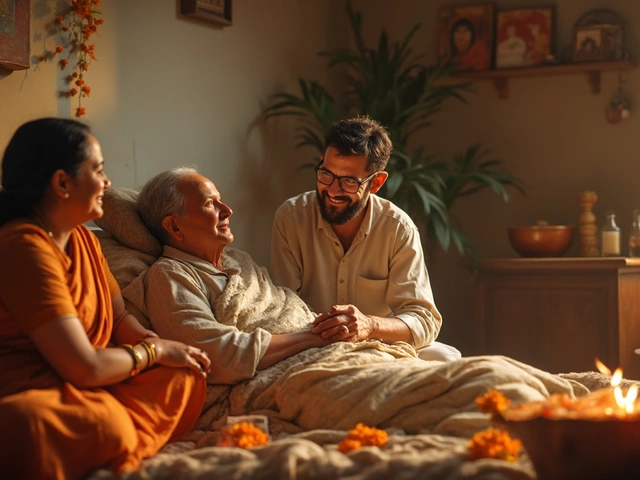A bottle of homemade herbal blend, a strict diet of kitchari, hours spent massaging mysterious oils into your skin—these aren’t scenes from a wellness retreat brochure but regular moments for thousands diving into an Ayurvedic cleanse. The promise? Stronger immunity, glowing skin, sharper focus. The catch? Your body may not always love the process. Talk to anyone who’s tried a cleanse—there’s always ‘that’ story, whether it’s racing to the bathroom or waking up dizzy on Day Three. Yet for all the glowing testimonials, there’s a surprising lack of real talk about what actually happens when you start flushing your body with ancient herbs and stop eating your usual food. Ready to pull back the curtain?
What Happens During an Ayurvedic Cleanse?
An Ayurvedic cleanse is a structured process aimed at detoxifying the body. Most of these cleanses are based on Panchakarma, a centuries-old set of therapies. At its core, a cleanse tries to reset your digestion, 'flush out toxins,' and restore balance to what practitioners call your doshas (Vata, Pitta, Kapha). That means you might spend days eating a monodiet of kitchari (a simple mung dal and rice stew), drink herbal teas, practice self-massage (abhyanga), and undergo therapies like oil pulling or even medicated enemas (basti). Some cleanses are as short as three days. The hardcore versions can last a month. The claims for these cleanses are eye-catching—reduced bloating, better sleep, calmer mind. But, the process isn’t just about glowing Instagram stories. Biochemically, your body is suddenly fed a radically different diet, often with fewer calories and less protein than you’re used to. Add new herbs and oils into the mix, and it’s clear this is more than your average home remedy.
Many people underestimate the extent to which these rapid shifts stress the body. For example, a sudden reduction in caffeine, sugar, and processed foods can trigger withdrawal-like symptoms even if you’re only cleansing for a week. The introduction of unfamiliar herbs like triphala, neem, or ashwagandha—in often higher doses than you’d get from a supplement—can interact with your liver, metabolism, and gut bacteria in ways you won’t ever notice with a typical diet. Dr. Vasant Lad, founder of The Ayurvedic Institute, once said,
"A cleanse should never leave a person feeling weak or ill. If you feel worse, you are not being cleansed—you are being harmed."But how do you know if what you're feeling is a side effect or part of the process?
Even seasoned fans admit the first few days of an Ayurvedic cleanse can feel like a rough ride. You might get headaches from caffeine withdrawal, nausea from certain herbs, or even diarrhea as your body pushes out what Ayurveda calls "ama" (toxic build-up). Each symptom has its own cause: the spicy ghee drink on an empty stomach, the extra hydration, or just the abrupt change from processed foods. There's no single blueprint here. What happens to one person might be totally different for the next, especially if you have underlying health issues, are pregnant, or take regular medications. The lack of customization is risky—many over-the-counter cleanse kits are based on a one-size-fits-all approach. A Danish study from 2020 found that up to 24% of people trying intense herbal cleanses reported moderate to severe digestive upset lasting several days. If you go it alone, without supervision from a trained practitioner, you’re going in blind.
And then there’s the question of restriction. Some cleanses cut out protein, salt, or fats almost entirely. This isn’t always safe if you have blood sugar fluctuations, anemia, or high physical activity levels. Supporters say short-term hardship is natural—detox days are all about ‘letting go’; critics say you could be compromising your nutrient intake just as your body kicks into overdrive trying to heal itself. The irony? If your gut isn’t healthy to begin with, radical food restrictions might actually leave you weaker, not stronger.

Most Common Ayurvedic Cleanse Side Effects
Nobody wants to talk about their third trip to the bathroom before lunch or feeling too drained to get off the couch, but those moments are common during strict Ayurvedic cleanses. Here’s what to expect, based on what regular people, Ayurvedic doctors, and a handful of clinical reviews say:
- Digestive Issues: Most people notice bloating, cramping, diarrhea, or constipation—sometimes all in a single day. That’s your digestive system adjusting to totally different foods and new herbs. Overuse of purgative herbs (like senna or triphala) can leave you scrambling for a toilet for hours, and in rare cases, trigger dehydration.
- Fatigue and Weakness: Switching from calorie-dense modern food to light kitchari and veggies can lead to general tiredness and sometimes stronger sensations like dizziness or even foggy brain. If you’re used to caffeine or chocolate, expect withdrawal headaches as your body ‘resets.’
- Headaches: These are extremely common in the first few days, especially if you’re cutting out caffeine, sugar, or salt at once.
- Mood Changes and Irritability: Restriction diets can bring mood swings, restlessness, or plain old grumpiness. You might also notice more anxiety if you’re suddenly eating much less or sleeping poorly.
- Changes in Sleep: Some folks feel sleepy all the time, while others get wired but restless. Again, it usually depends on your baseline sleep, eating habits, and how strictly you’re following the cleanse protocol.
- Detox Rash or Skin Issues: Certain herbs or oils can cause rashes, breakouts, or itching—sometimes as part of the so-called ‘healing crisis,’ when your body pushes toxins out through your skin.
- Flu-like Symptoms: It’s not unusual to get chills, mild fever, or aches for a day or two. This tends to resolve as your body adapts, but the sensation can be pretty intense.
- Low Blood Pressure and Dizziness: Long periods with lower sodium and calories can cause blood pressure to drop, especially if you stand up quickly or spend a lot of time sweating (common with steam therapies in Panchakarma settings).
For some, these side effects peak in the first 48 hours and taper off as you settle into the routine. For others, especially those with sensitive guts or existing health issues, the symptoms can linger. A review published in Journal of Alternative and Complementary Medicine in 2019 noted that up to 18% of patients who completed a two-week supervised Panchakarma program still reported mild GI distress or sleep troubles a week after finishing. That may sound minor, but if you’re juggling work, kids, or travel, it can mess up your schedule in a big way.
There are less common but more serious risks, too. If you’re taking blood thinners, for instance, herbs like ashwagandha or turmeric in large amounts may interact and heighten bleeding risk. Cleanses can also mess with blood sugar balance, making it risky for those with diabetes or hypoglycemia.
Let’s get concrete: here’s an actual breakdown of the most reported side effects and how often they show up, based on a blend of clinical reviews and published user surveys:
| Side Effect | Reported Frequency (%) |
|---|---|
| Bloating/Cramping | 42 |
| Diarrhea/Loose Stools | 37 |
| Headaches | 30 |
| Fatigue/Weakness | 47 |
| Mood Swings/Irritability | 28 |
| Rash/Skin Issues | 15 |
| Body Aches | 11 |
| Nausea/Vomiting | 19 |
Notice those numbers aren’t small. Nearly half of people reported feeling weak or tired at some point—so don’t beat yourself up if a cleanse isn’t a walk in the park for you.

How to Minimize Ayurvedic Cleanse Risks and Get Better Results
If the side effects seem intimidating, there’s some good news: you can make a cleanse much safer and easier if you prep well and listen to your body. The first step is to avoid one-size-fits-all kits. Customization matters. Ayurveda is supposed to be tailored to your unique dosha type, medical history, and even your current stress level. Authentic practitioners spend hours asking about your specific digestion, emotional health, and lifestyle before giving you the green light for a cleanse. If you pick up a pre-boxed regimen from a random shop or website, you’re missing all that nuance—and setting yourself up for trouble.
Start slow. If you’re used to heavy meals, coffee, or processed foods, start cutting back a week or two before you get going. That means less sugar, less caffeine, and more simple, cooked meals. If you can, book a consultation with a trained Ayurvedic doctor or at least check in virtually. If you’re pregnant, taking regular medications, have diabetes or chronic disease, skip unsupervised cleanses altogether. Some herbs—like senna, castor oil, or guggul—can cause major interactions with blood pressure meds, anti-inflammatories, and even birth control.
During the cleanse itself, go easy on the exercise. Gentle walks, light yoga, or simple stretching are better than running marathons or pumping iron. The idea is to support your body while it’s focused on repair and elimination, not push it to new extremes.
- Drink plenty of clean, warm water, but don’t drown yourself in it—too much liquid can actually lower your salt levels.
- Listen to your hunger cues. A little hunger is normal in a cleanse, but serious weakness or dizziness isn’t. Don’t be afraid to eat an extra bowl of kitchari or steamed veggies if you feel faint.
- If you feel extremely unwell (severe pain, persistent vomiting, fainting), stop the cleanse and seek help. That’s not a ‘healing crisis’—that’s a warning sign.
- Add turmeric or ginger tea if you’re having mild cramps or aches—the anti-inflammatory and soothing effects are real, but keep it mild and check for allergies.
- Take days off from work, social commitments, or heavy chores if possible—your body’s already working overtime.
- Use natural, hypoallergenic oils for self-massage (plain coconut or sesame is best) and avoid unfamiliar blends if you have sensitive skin.
If you’re someone who likes tech, fitness trackers can be handy to monitor your heart rate, sleep, and movement—watch for unusual dips or spikes and treat them as a sign to check in with a health professional.
Don’t expect instant results. Ayurvedic doctors say the true benefits come in the weeks after finishing—which might mean less dramatic ‘aha!’ moments during, and more subtle gains later.
“Detoxification is not a sprint, it’s a gentle marathon,” says Dr. Suhas Kshirsagar, a well-known integrative medicine specialist. “The goal isn’t to lose weight or reset overnight, but to ease the burden on your digestive fire so your body can heal on its own timeline.”Studies back this up: people who follow moderate, supervised cleanses are far less likely to report severe side effects compared to those doing aggressive DIY plans from internet recipes.
Above all, if you’re thinking about a cleanse because you feel constantly sluggish, bloated, or off, remember there’s usually a reason beneath the surface. A short-term Ayurvedic cleanse can offer a reset, but if your symptoms persist afterward, it’s time to see your GP and dig deeper. Sometimes you need something stronger than herbs—and that’s not a failure, just smart self-care.



